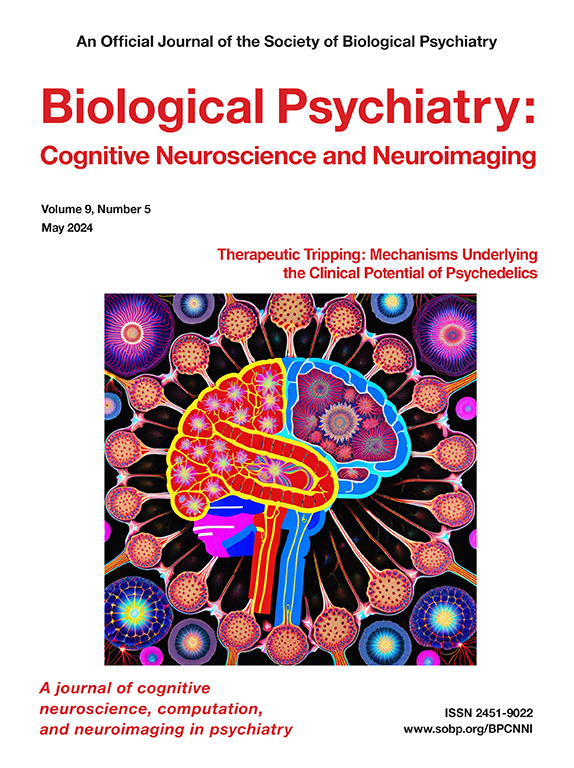A Preliminary Study of Brain Developmental Features of Bipolar Disorder Familial Risk and Subthreshold Symptoms
IF 4.8
2区 医学
Q1 NEUROSCIENCES
Biological Psychiatry-Cognitive Neuroscience and Neuroimaging
Pub Date : 2025-07-01
DOI:10.1016/j.bpsc.2024.06.005
引用次数: 0
Abstract
Background
Risk for bipolar disorder (BD) is increased among individuals with a family history or subthreshold mood symptoms. However, the brain structural developments associated with these BD risks remain unknown.
Methods
This longitudinal cohort study examined the brain gray matter volume (GMV) developmental features of familial and symptomatic risks for BD and their associations with participants’ global function levels. We recruited unaffected BD offspring with (n = 26, 14 female, mean ± SD age = 14.9 ± 2.9 years) or without (n = 35, 19 female, age = 15.3 ± 2.7 years) subthreshold manic or depressive symptoms and unaffected non-BD offspring with (n = 49, 30 female, age = 14.5 ± 2.2 years) or without (n = 68, 37 female, age = 15.0 ± 2.3 years) symptoms. The offspring had no mood disorder diagnosis prior to the study. The average follow-up duration was 2.63 ± 1.63 years.
Results
At baseline, we found significant interactive effects of familial risk and subthreshold symptoms that indicated that the symptomatic offspring exhibited markedly large GMV in the brain affective and cognitive circuitries. During follow-up, the combined group of BD offspring (symptomatic and nonsymptomatic) displayed a more accelerated GMV decrease than BD nonoffspring in the hippocampus and anterior cingulate cortex. In contrast, the combined group of symptomatic participants (offspring and nonoffspring) displayed a slower GMV decrease than nonsymptomatic participants in the ventromedial prefrontal cortex. Larger GMV at baseline and accelerated GMV decrease during follow-up prospectively and longitudinally predicted positive global function changes. All results survived multiple testing correction.
Conclusions
These findings indicated that familial and symptomatic risks of BD are associated with distinct brain structural developments and unraveled key brain developmental features of particularly vulnerable high-risk individuals to subsequent functional deterioration.
关于躁郁症家族风险和阈下症状的大脑发育特征的初步研究。
背景:有家族史或阈下情绪症状的人患双相情感障碍(BD)的风险会增加。然而,与这些躁郁症风险相关的大脑结构发育情况仍不为人知:这项纵向队列研究考察了家族性躁狂症风险和有症状躁狂症风险的大脑灰质体积(GMV)发育特征,以及它们与参与者的整体功能水平之间的关系。我们招募了具有(N=26,年龄=14.9±2.9岁,女性14人)或不具有(N=35,年龄=15.3±2.7岁,女性19人)阈下躁狂或抑郁症状的未受影响的BD后代,以及具有(N=49,年龄=14.5±2.2岁,女性30人)或不具有(N=68,年龄=15.0±2.3岁,女性37人)症状的未受影响的非BD后代。在研究之前,后代没有情绪障碍诊断。平均随访时间为 2.63±1.63 年:结果:我们发现,在基线时,家族风险和阈下症状的显著交互效应表明,有症状的后代在大脑情感和认知回路中表现出明显的巨大GMV。在随访期间,合并的 BD 后代组(有症状和无症状)在海马和前扣带回皮层的 GMV 比非 BD 后代组下降得更快。相比之下,有症状参与者(后代和非后代)的腹外侧前额叶皮层的 GMV 下降速度慢于无症状参与者。基线时更大的GMV和随访期间更快的GMV下降,可前瞻性地纵向预测积极的整体功能变化。所有结果均通过多重检验校正:这些研究结果表明,BD的家族性和无症状风险与不同的大脑结构发育有关,并揭示了特别易受随后功能退化影响的高危人群的关键大脑发育特征。
本文章由计算机程序翻译,如有差异,请以英文原文为准。
求助全文
约1分钟内获得全文
求助全文
来源期刊

Biological Psychiatry-Cognitive Neuroscience and Neuroimaging
Neuroscience-Biological Psychiatry
CiteScore
10.40
自引率
1.70%
发文量
247
审稿时长
30 days
期刊介绍:
Biological Psychiatry: Cognitive Neuroscience and Neuroimaging is an official journal of the Society for Biological Psychiatry, whose purpose is to promote excellence in scientific research and education in fields that investigate the nature, causes, mechanisms, and treatments of disorders of thought, emotion, or behavior. In accord with this mission, this peer-reviewed, rapid-publication, international journal focuses on studies using the tools and constructs of cognitive neuroscience, including the full range of non-invasive neuroimaging and human extra- and intracranial physiological recording methodologies. It publishes both basic and clinical studies, including those that incorporate genetic data, pharmacological challenges, and computational modeling approaches. The journal publishes novel results of original research which represent an important new lead or significant impact on the field. Reviews and commentaries that focus on topics of current research and interest are also encouraged.
 求助内容:
求助内容: 应助结果提醒方式:
应助结果提醒方式:


